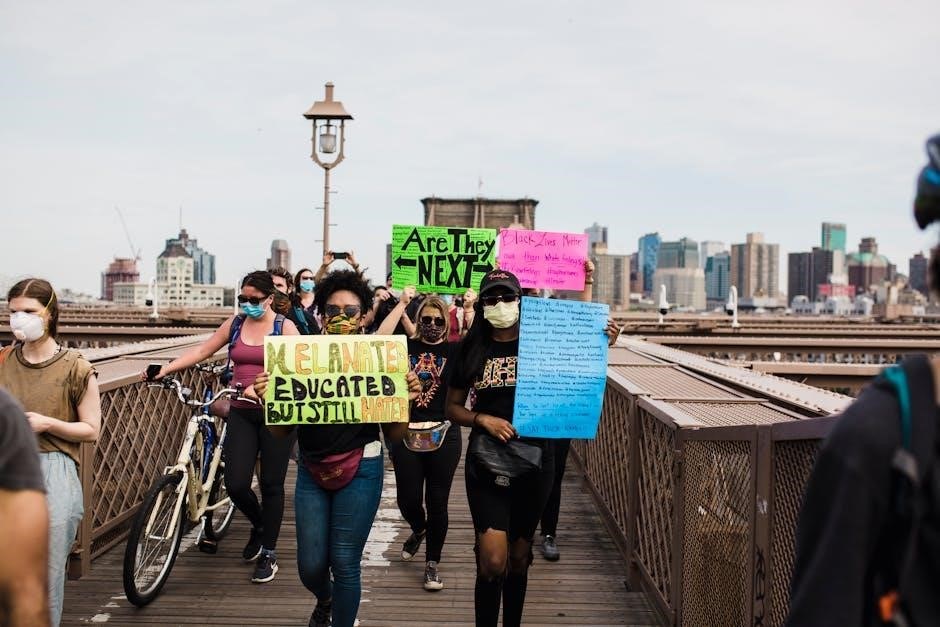Organizing for social change empowers individuals and communities to address systemic issues, fostering equity and justice through collective action and grassroots efforts. It requires a clear vision, strategic planning, and collaboration to drive meaningful transformation.

The Importance of Social Change and Activism
Social change and activism are essential for addressing systemic inequalities, injustice, and societal problems. Activism empowers individuals and communities to challenge oppressive systems, advocate for human rights, and create a more equitable world. It fosters collective action, raising awareness about critical issues and mobilizing people to demand transformative solutions. Through activism, marginalized voices gain strength, and grassroots movements drive meaningful policy reforms. The importance of social change lies in its ability to dismantle structures of oppression and promote justice, ensuring that all individuals can thrive. By engaging in activism, people contribute to a legacy of progress, inspiring future generations to continue the fight for a fair and just society.
Understanding the Role of an Activist
An activist plays a crucial role in driving social change by advocating for justice and human rights. Their primary responsibility is to identify and address systemic issues, mobilizing communities to take collective action. Activists educate others on key problems, amplify marginalized voices, and challenge oppressive structures. They often engage in grassroots organizing, protests, and campaigns to bring attention to their cause. Effective activists are passionate, empathetic, and strategic, using their skills to inspire and empower others. By fostering collaboration and resilience, activists help build movements that lead to lasting change. Their dedication ensures that marginalized communities have a voice and that societal progress remains a constant pursuit. Activists are essential catalysts for creating a more equitable and just world.

Building a Theory of Change
A theory of change maps how actions lead to desired social outcomes, guiding activists to align strategies with clear goals and measurable impact.
Defining Your Cause and Vision
Defining your cause and vision is the cornerstone of effective activism. It involves identifying the core issue you aim to address and the future you envision. A clear cause provides direction, while a compelling vision inspires and unites people. Start by understanding the root of the problem and the values driving your movement. Use specific keywords and search queries to research your topic thoroughly, ensuring your cause is well-defined. Your vision should be aspirational yet achievable, serving as a guiding light for your efforts. Without a strong cause and vision, movements risk losing focus and momentum. This clarity also helps in crafting powerful narratives and strategies, ensuring your activism remains purposeful and impactful.
Assessing the Community and Its Needs
Assessing the community and its needs is a critical step in organizing for social change. Understanding the dynamics, challenges, and aspirations of the community ensures that your efforts are relevant and effective. Start by gathering data through surveys, interviews, and focus groups to identify key issues. Analyze the community’s strengths, weaknesses, opportunities, and threats (SWOT analysis) to pinpoint areas for intervention. Building trust is essential, so engage with local leaders and residents to ensure their voices are heard. This process helps tailor your strategies to the community’s unique context, fostering ownership and participation. A thorough assessment also reveals potential allies and resources, maximizing your impact. By grounding your work in the community’s reality, you create a foundation for sustainable and meaningful change. This step ensures your activism is both inclusive and responsive to real needs.
Grassroots Organizing Strategies
Grassroots organizing is a community-driven approach that empowers individuals to collectively address social issues. It involves building relationships, mobilizing resources, and fostering trust to create lasting change.
Building Relationships and Trust in the Community

Building relationships and trust in the community is foundational to effective grassroots organizing. It involves active listening, respecting the community’s needs, and fostering genuine connections. Empowering local leaders and amplifying their voices strengthens trust and credibility. Transparency in actions and intentions ensures reliability, while consistent engagement fosters long-term partnerships. Trust is built through shared goals, mutual respect, and collaborative decision-making. These relationships create a resilient network capable of driving social change and sustaining momentum over time.
Mobilizing Communities for Collective Action
Mobilizing communities for collective action requires clear goals, inclusive decision-making, and strategic engagement. Start by identifying key stakeholders and amplifying their voices to foster ownership. Use nonviolent tactics and peaceful protests to demonstrate unity and urgency. Training community members in advocacy skills empowers them to take action confidently. Ensure messaging is simple, compelling, and resonates with diverse groups. Build momentum through consistent actions, leveraging local leaders to inspire broader participation. Regular communication and feedback loops sustain engagement and adapt strategies as needed. Collective action thrives when communities feel empowered, heard, and united toward a common vision.

Effective Communication and Messaging
- Craft a clear, compelling narrative to inspire action and convey your vision.
- Tailor messages to resonate with diverse audiences and build empathy.
- Use media and technology to amplify your voice and expand reach.
- Engage in active listening to understand community needs and concerns.
- Consistently repeat key messages to reinforce your cause and unify supporters.
Crafting a Compelling Narrative for Social Change
Crafting a compelling narrative is essential for inspiring action and connecting with audiences. A strong narrative should be rooted in personal stories, highlighting the human impact of the issue. Use clear, simple language to convey complex ideas, ensuring your message is accessible to all. Emotional connections are key—share relatable experiences to foster empathy and urgency. Highlight shared values and a vision for a better future to unite people behind your cause. Consistency is crucial; repeat your core message across platforms to reinforce your mission. Tailor your narrative to resonate with diverse audiences, addressing their unique concerns and hopes. A well-crafted story can transform apathy into action, driving meaningful social change and mobilizing communities to fight for justice and equality.
Leveraging Media and Technology for Advocacy
Leveraging media and technology is vital for amplifying your message and reaching broader audiences. Social media platforms, email campaigns, and online petitions can mobilize support and create viral movements. Use hashtags to increase visibility and engage with influencers to expand your reach. Tools like CRM systems can help manage relationships with supporters and track engagement. Analyze data to refine your strategies and measure impact. Consistency in messaging across platforms ensures a unified voice. Authenticity and transparency build trust, fostering stronger connections with your audience. By integrating technology into your advocacy, you can efficiently organize, communicate, and inspire action on a larger scale, driving momentum for social change and fostering a sense of community among advocates.

Leadership Development
Leadership development is crucial for empowering activists to guide movements effectively. It involves nurturing skills, fostering resilience, and creating sustainable structures to support long-term social change efforts successfully.
Identifying and Empowering Local Leaders
Identifying and empowering local leaders is a cornerstone of effective grassroots organizing. Local leaders are individuals who possess credibility, trust, and influence within their communities. They often have a deep understanding of local issues and can mobilize others to take action. To identify these leaders, activists should engage in community outreach, listen to voices that resonate with others, and observe who naturally takes initiative. Empowering these leaders involves providing them with resources, training, and support to amplify their impact. This includes fostering their leadership skills, encouraging decision-making authority, and creating spaces for collaboration. By nurturing local leaders, movements can build sustainability and ensure that change is driven by those most affected by the issues. This approach not only strengthens the community but also ensures that activism remains grounded and authentic.
Training and Capacity Building for Activists

Training and capacity building are essential for equipping activists with the skills and knowledge needed to drive social change effectively. Through workshops, mentorship programs, and hands-on experience, activists can develop expertise in areas such as strategic planning, communication, and community engagement. These initiatives help build confidence and resilience, enabling activists to navigate challenges and sustain their efforts over time. Capacity building also involves fostering emotional intelligence, conflict resolution skills, and the ability to adapt to changing circumstances. By investing in the growth of activists, movements can ensure a stronger, more informed, and resilient base of leaders capable of advancing their cause. Continuous learning and skill development are critical for maintaining momentum and achieving long-term impact in social change efforts.
Strategies for Nonviolent Social Change
Strategies for nonviolent social change emphasize the power of peaceful resistance, dialogue, and community empowerment to create lasting impact without violence or harm.
Principles of Nonviolent Action

Nonviolent action is rooted in the belief that social change can be achieved through peaceful means. It emphasizes respect for human rights, dignity, and the well-being of all individuals. Key principles include avoiding physical harm, fostering dialogue, and engaging in acts of civil disobedience to challenge unjust systems. Nonviolent strategies often involve education, community participation, and the use of symbolic actions to draw attention to injustices. By promoting empathy and understanding, nonviolent action creates space for constructive conflict resolution and sustainable change. These principles are foundational to movements that seek to empower marginalized communities and address systemic inequalities without resorting to violence or coercion. They inspire hope and unity, demonstrating the power of collective action for justice and equality.
Planning and Executing Peaceful Protests

Planning and executing peaceful protests requires careful organization and attention to detail to ensure safety, legality, and impact. Start by defining clear objectives and choosing a strategic location and time. Obtain necessary permits and coordinate with local authorities to avoid legal issues. Promote the event through social media, flyers, and community networks to maximize participation. On the day of the protest, ensure a clear program with speakers, chants, and visual elements to convey your message. Train volunteers to manage crowds and handle potential conflicts peacefully. Safety is paramount—plan for first aid, legal observers, and contingency strategies. After the event, debrief with participants, document outcomes, and follow up with stakeholders to sustain momentum. Nonviolent principles should guide every step to maintain integrity and achieve lasting change.
Resource Management and Sustainability
Effective resource management ensures the longevity and impact of social change initiatives by mobilizing funds, materials, and human capital efficiently, while fostering sustainable practices and community engagement.
Securing Funding and Resources
Securing funding and resources is crucial for sustaining social change initiatives. Activists can explore diverse funding sources, including grants, crowdfunding, and corporate sponsorships. Developing a robust funding strategy involves identifying potential donors, creating compelling proposals, and building relationships with stakeholders. Additionally, leveraging in-kind donations and volunteer support can amplify resource capacity. Utilizing online platforms and social media can enhance visibility and attract broader support. Transparency and accountability in resource management are essential for maintaining trust and ensuring long-term sustainability of the movement. By diversifying funding streams and engaging the community, activists can build a resilient foundation for their cause.
Building a Sustainable Movement
Building a sustainable movement requires long-term planning, community engagement, and adaptability. Activists must foster a culture of resilience, ensuring the movement withstands challenges and evolves over time. This involves nurturing leadership at all levels, empowering individuals to take ownership of the cause. Establishing clear goals, values, and decision-making processes helps maintain direction and unity. Leveraging technology and networks can expand reach and resources, while inclusive practices ensure diverse voices are represented. Sustaining momentum also depends on celebrating successes, learning from setbacks, and continuously inspiring new supporters. A sustainable movement is rooted in community trust, shared vision, and the ability to adapt while remaining committed to its core principles.

Organizing for social change is a powerful journey that empowers activists to create lasting impact by fostering equity, justice, and collective action for a better future.
Measuring Impact and Scaling Change
Measuring the impact of social change efforts is crucial to understanding progress and identifying areas for improvement. Activists can use data collection tools, surveys, and community feedback to assess their initiatives’ effectiveness. Scaling change involves expanding successful strategies to broader audiences or regions, ensuring sustainability and long-term influence. Leveraging technology, partnerships, and resources can amplify reach and deepen impact. Regular evaluation and adaptation are essential to maintain relevance and effectiveness. By learning from outcomes and refining approaches, activists can create lasting, transformative change that resonates across communities and inspires further action. This process ensures that efforts evolve and grow, contributing to a more equitable and just society.
